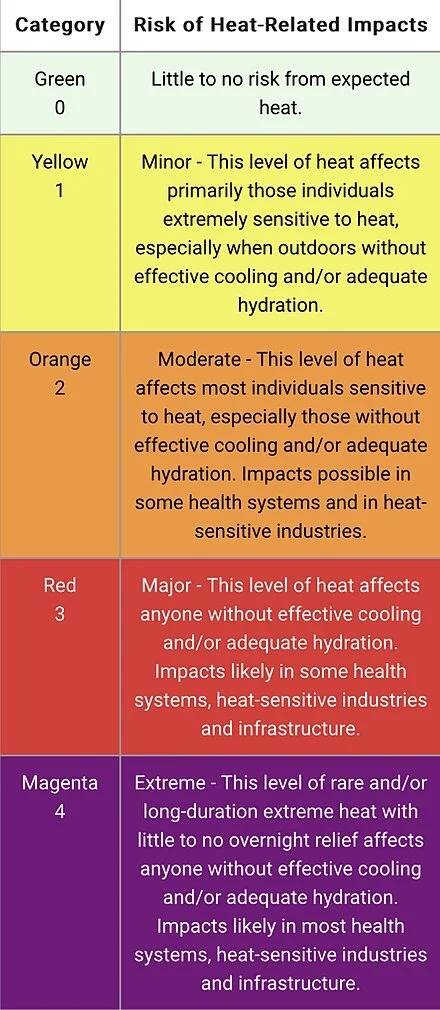Martha Bebinger: In Mass. and beyond, health-care workers confront the rising dangers from a warming climate
The National Weather Service risk categories for heat
Boston and some adjoining communities
Text via KFF Health News in partnership with WBUR and NPR
BOSTON
An important email appeared in the inboxes of a small group of health-care workers north of this city as this summer started. It warned that local temperatures were rising into the 80s.
An 80-plus-degree day is not sizzling by Phoenix standards. Even in Boston, it wasn’t high enough to trigger an official heat warning for the wider public.
But research has shown that those temperatures, coming so early in June, would likely drive up the number of heat-related hospital visits and deaths across Greater Boston.
The targeted email alert the doctors and nurses at Cambridge Health Alliance, in Somerville, Mass,, got that day is part of a pilot project run by the nonprofit Climate Central and Harvard University’s Center for Climate, Health and the Global Environment, known as C-CHANGE.
Medical clinicians based at 12 community-based clinics in seven states — California, Massachusetts, North Carolina, Oregon, Pennsylvania, Texas and Wisconsin — are receiving these alerts.
At each location, the first email alert of the season was triggered when local temperatures reached the 90th percentile for that community. In a suburb of Portland, Ore., that happened on May 14 during a springtime heat wave. In Houston, that occurred in early June.
A second email alert went out when forecasts indicated the thermometer would reach the 95th percentile. For Cambridge Health Alliance primary- care physician Rebecca Rogers, that second alert arrived on July 6, when the high hit 87 degrees.
The emails remind Rogers and other clinicians to focus on patients who are particularly vulnerable to heat. That includes outdoor workers, older adults, or patients with heart disease, diabetes, or kidney disease.
Other at-risk groups include youth athletes and people who can’t afford air conditioning, and/or who don’t have stable housing. Heat has been linked to complications during a pregnancy as well.
“Heat can be dangerous to all of us,” said Caleb Dresser, director of health- care solutions at C-CHANGE. “But the impacts are incredibly uneven based on who you are, where you live, and what type of resources you have.”
The pilot program aims to remind clinicians to start talking to patients about how to protect themselves on dangerously hot days, which are happening more frequently because of climate change. Heat is already the leading cause of death in the U.S. from weather-related hazards, Dresser said. Letting clinicians know when temperatures pose a particular threat to their patients could save lives.
“What we’re trying to say is, ‘You really need to go into heat mode now,'” said Andrew Pershing, vice president for science at Climate Central, with a recognition that “it’s going to be more dangerous for folks in your community who are more stressed.”
“This is not your grandmother’s heat,” said Ashley Ward, who directs the Heat Policy Innovation Hub, at Duke University. “The heat regime that we are seeing now is not what we experienced 10 or 20 years ago. So we have to accept that our environment has changed. This might very well be the coolest summer for the rest of our lives.”
The alerts bumped heat to the forefront of Rogers’s conversations with patients. She made time to ask each person whether they can cool off at home and at work.
That’s how she learned that one of her patients, Luciano Gomes, works in construction.
“If you were getting too hot at work and maybe starting to feel sick, do you know some things to look out for?” Rogers asked Gomes.
“No,” said Gomes slowly, shaking his head.
Rogers told Gomes about early signs of heat exhaustion: dizziness, weakness, or profuse sweating. She handed Gomes tip sheets she’d printed out after receiving them along with the email alerts.
They included information about how to avoid heat exhaustion and dehydration, as well as specific guidance for patients with asthma, chronic obstructive pulmonary disease (COPD), dementia, diabetes, multiple sclerosis and mental-health concerns.
Rogers pointed out a color chart that ranges from pale yellow to dark gold. It’s a sort of hydration barometer, based on the color of one’s urine.
“So if your pee is dark like this during the day when you’re at work,” she told Gomes, “it probably means you need to drink more water.”
Gomes nodded. “This is more than you were expecting to talk about when you came to the doctor today, I think,” she said with a laugh.
During this visit, an interpreter translated the visit and information into Portuguese for Gomes, who is from Brazil and quite familiar with heat. But he now had questions for Rogers about the best ways to stay hydrated.
“Because here I’ve been addicted to soda,” Gomes told Rogers through the interpreter. “I’m trying to watch out for that and change to sparkling water. But I don’t have much knowledge on how much I can take of it.”
“As long as it doesn’t have sugar, it’s totally good,” Rogers said.
Now Rogers creates heat-mitigation plans with each of her high-risk patients. But she still has medical questions that the research doesn’t yet address. For example: If patients take medications that make them urinate more often, could that lead to dehydration when it’s hot? Should she reduce their doses during the warmest weeks or months? And, if so, by how much? Research has yielded no firm answers to those questions.
Deidre Alessio, a nurse practitioner at Cambridge Health Alliance, also has received the email alerts. She has patients who sleep on the streets or in tents and search for places to cool off during the day.
“Getting these alerts makes me realize that I need to do more homework on the cities and towns where my patients live,” she said, “and help them find transportation to a cooling center.”
Most clinics and hospitals don’t have heat alerts built into electronic medical records, don’t filter patients based on heat vulnerability, and don’t have systems in place to send heat warnings to some or all of their patients.
“I would love to see health care institutions get the resources to staff the appropriate outreach,” said Gaurab Basu, a Cambridge Health Alliance physician who co-directs the Center for Health Equity Advocacy and Education at Cambridge Health Alliance. “But hospital systems are still really strained by COVID and staffing issues.”
This pilot program is an excellent start and could benefit by including pharmacists, said Kristie Ebi, founding director of the Center for Health and the Global Environment, at the University of Washington.
Ebi has studied heat early-warning systems for 25 years. She says one problem is that too many people don’t take heat warnings seriously. In a survey of Americans who experienced heat waves in four cities, only about half of residents took precautions to avoid harm to their health.
“We need more behavioral-health research,” she said, “to really understand how to motivate people who don’t perceive themselves to be at risk, to take action.”
For Ebi and other researchers, the call to action is not just to protect individual health, but to address the root cause of rising temperatures: climate change.
“We’ll be dealing with increased exposure to heat for the rest of our lives,” said Dresser. “To address the factors that put people at risk during heat waves, we have to move away from fossil fuels so that climate change doesn’t get as bad as it could.”
Martha Bebinger is a reporter at WBUR, in Boston
marthab@wbur.org, @mbebinger

